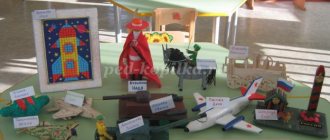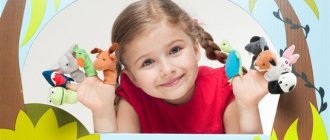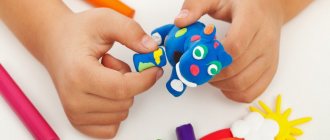Project “Joint creative activity of children and their parents in the educational process”
MUDO Center for Additional Education of Children in Avsyunino
Orekhovo-Zuevsky urban district, Moscow region
Project
“Joint creative activity of children and their parents
in the educational process"
The author of the project is a teacher of additional education
highest qualification category
Kuritsina Elena Konstantinovna
2020
“Joint creative activity of children and their parents
in the educational process"
The key task of modern state policy of the Russian Federation is to ensure the spiritual and moral development and education of the personality of a Russian citizen.
“Spiritual and moral development and education of the individual begins in the family. It is family values, acquired by a child from the first years of life, that are of lasting importance for a person at any age and form the basis of civil behavior in society.”
Parents play a vital role in a child's life. Parental love is the source and guarantee of human well-being, maintaining physical and mental health. That is why the first and main task of parents is to create confidence in the child that he is loved and cared for. Deep, constant psychological contact with parents gives the child the opportunity to feel and realize parental love, affection and care.
The basis for maintaining psychological contact is a sincere interest in everything that happens in a child’s life, sincere curiosity about his childhood, even the most trivial and naive, problems, a desire to understand, a desire to observe all the changes that occur in the soul and consciousness of a growing person. It is necessary to communicate with children from a young age: without communication, without constant concern for arranging common leisure time and common affairs with them, parents will not be interested in their own children.
The main values of educational activities in the system of additional education are the child, his development, childhood as the special life of a child, educational space as an environment conducive to personal development. Therefore, additional education has great potential to help parents establish and maintain psychological contact with the child, spiritual and moral development and education of all participants in the educational process.
One of the forms of interaction between additional education institutions and students’ families is family clubs and workshops. Organized joint creative activity is the inclusion of the parent in the child’s activity. This is a situation in which a child, faced with a certain difficulty, has the opportunity to turn to a parent for help. And the parent gets the opportunity to do the work together with the child. As a result of joint creative activity and common interests, the child and parent reach mutual understanding and become closer to each other.
Features of the implementation of the design method in preschool educational institutions
The project method can be represented as a way of organizing the educational process, based on the interaction between teacher and student, a way of interacting with the environment, and step-by-step practical activities to achieve a set goal.
The transfer of a preschool institution to a project-based method of activity is usually carried out in the following stages:
- Classes including problematic situations of children's experimentation, etc.;
- integrated topic block classes;
- integration: partial or complete;
- project method as a form of organizing educational space; as a method for developing creative cognitive thinking.
Work in this direction is implemented primarily through the training of teachers, educational work with parents, and the creation of a subject-spatial environment in accordance with the requirements of the design method.
The implementation of the above technology imposes certain requirements on the teacher as a creative person and special training to improve pedagogical professionalism, since a teacher who masters the project method as a technology and as an activity for co-creating a professional space can teach a child to design.
The teacher acts as an organizer of children's productive activities, as a source of information, as a consultant, as an expert. He is the main leader of the project and subsequent research, gaming, artistic, practical activities, the coordinator of individual and group efforts of children in solving the problem. Therefore, the introduction of the project method into practice begins with organizing work with the teaching staff. These can be the following methods and forms of work: seminars, consultations, joint viewing of lessons, simulation games, methodological exhibitions, master classes, conversations, debates, workshops, trainings, round tables, work with teaching materials, days of mutual visits, project presentations. Exemplary projects on working with human resources are presented in Appendix 2.
The main goal of introducing the project method in a preschool institution is the development of the child’s free creative personality, which is determined by the developmental goals and objectives of children’s research activities.
The goal is to determine learning goals, create learning conditions and research skills in accordance with the main lines of development. The project method gives the child the opportunity to:
- experiment, synthesize acquired knowledge;
- develop their creativity and communication skills, which allows them to successfully adapt to the changing learning situation at school.
The project method can be used in working with children not only of older, but also of younger preschool age. The objectives of research activities are specific for each age and make it possible to determine learning goals and create conditions for the formation of educational and research skills in accordance with the main lines of development.
To implement the project, the teacher determines the stages of implementation, thinks through the content of the activity and selects practical material. In this case, when planning project activities, the teacher must remember the three stages of development of project activities in preschoolers, which are one of the pedagogical technologies of project activities, including a set of research, search, problem-oriented, creative methods.
The first stage is imitation and performance, the implementation of which is possible in children aged 3.5-5 years. At this stage, children participate in the project “in a secondary role”, perform actions at the direct suggestion of an adult or through his imitation, which does not contradict the nature of a small child; at this age there is still a need to form and maintain a positive attitude towards an adult and imitate him.
Tasks of younger preschool age
Thus, in primary preschool age the tasks are as follows:
- stimulate interest in the proposed activities;
- involve children in the learning process;
- for the formation of various concepts;
- Involve children in reproducing pictures using a variety of options;
- Encourage children to jointly explore and experiment.
Improvement of mental processes:
- Formation of emotional interest;
- Familiarization with objects and actions with them;
- development of thinking and imagination;
- Language development.
Formation of skills and abilities of project research:
- awareness of the goal;
- Possession of various methods of solving assigned problems;
- Ability to predict results based on past experience;
- Look for different means to achieve your goal.
Lines of personality development in early preschool age according to directions.
1) Physical development:
- Stimulating the natural process of development of motor skills and qualities;
- Formation of conscious ideas about the need to take care of one’s own health (for example, the role-playing project “The ABC of Health”);
- Social development: formation of communication methods (for example, opening “My Family”, individual family projects “Family Tree”).
2) Cognitive development:
- Enrichment and expansion of ideas about the world around us;
- expansion and qualitative change in the possibilities of orientation in the surrounding world;
- conscious use of the senses when solving practical problems (for example, mathematical collages, intergroup project “The World of Animals and Birds”, creative projects “My Friends”, “The World of Nature”).
3) Aesthetic development:
- Development of an emotional-evaluative attitude towards works of art and artistic images;
- Mastery of artistic activities (for example, complex projects “World of Theater”, role-playing projects “Favorite Toys”, etc.).
The second stage is developmental, it is typical for children 5-6 years old, who already have experience in various joint activities, can coordinate actions, and help each other. The child makes requests to adults less often and organizes joint activities with peers more actively.
Children develop self-control and self-esteem; They are able to fairly objectively evaluate their own actions and the actions of their peers. At this age, children accept the problem, clarify the goal and are able to choose the means necessary to achieve the result of the activity. They not only show a willingness to participate in projects proposed by adults, but also find problems on their own.
The third stage is creative, it is typical for children aged 6-7 years. At this stage, it is very important that adults develop and support children’s creative activity, create conditions so that children can independently determine the purpose and content of the upcoming activity, choose a way to work on a project and be able to organize it.




